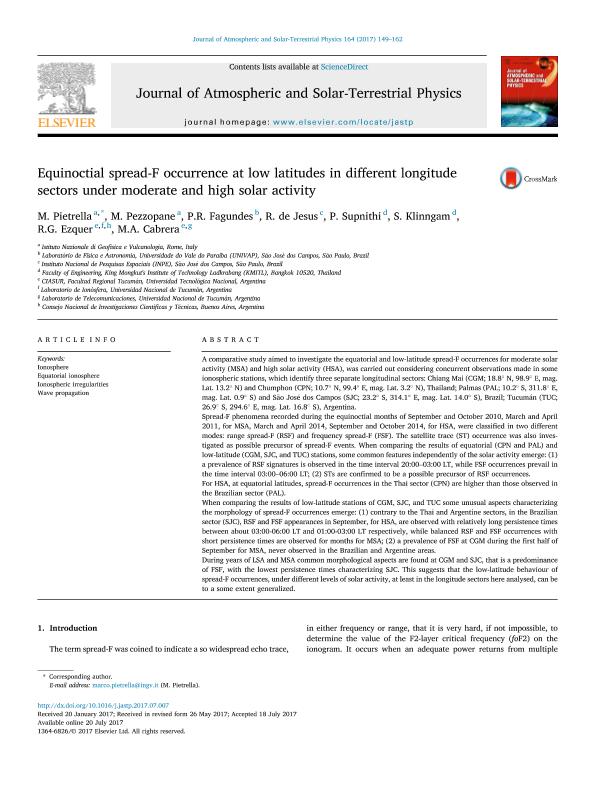Mostrar el registro sencillo del ítem
dc.contributor.author
Pietrella, M.
dc.contributor.author
Pezzopane, M
dc.contributor.author
Fagundes, P. R.
dc.contributor.author
de Jesús, R.
dc.contributor.author
Supnithi, P.
dc.contributor.author
Klinngam, S.
dc.contributor.author
Ezquer, Rodolfo Gerardo

dc.contributor.author
Cabrera, Miguel Angel

dc.date.available
2019-02-12T17:22:58Z
dc.date.issued
2017-11
dc.identifier.citation
Pietrella, M.; Pezzopane, M; Fagundes, P. R.; de Jesús, R.; Supnithi, P.; et al.; Equinoctial spread-F occurrence at low latitudes in different longitude sectors under moderate and high solar activity; Elsevier; Journal of Atmospheric and Solar-Terrestrial Physics; 164; 11-2017; 149-162
dc.identifier.issn
1364-6826
dc.identifier.uri
http://hdl.handle.net/11336/69970
dc.description.abstract
A comparative study aimed to investigate the equatorial and low-latitude spread-F occurrences for moderate solar activity (MSA) and high solar activity (HSA), was carried out considering concurrent observations made in some ionospheric stations, which identify three separate longitudinal sectors: Chiang Mai (CGM; 18.8° N, 98.9° E, mag. Lat. 13.2° N) and Chumphon (CPN; 10.7° N, 99.4° E, mag. Lat. 3.2° N), Thailand; Palmas (PAL; 10.2° S, 311.8° E, mag. Lat. 0.9° S) and São José dos Campos (SJC; 23.2° S, 314.1° E, mag. Lat. 14.0° S), Brazil; Tucumán (TUC; 26.9° S, 294.6° E, mag. Lat. 16.8° S), Argentina. Spread-F phenomena recorded during the equinoctial months of September and October 2010, March and April 2011, for MSA, March and April 2014, September and October 2014, for HSA, were classified in two different modes: range spread-F (RSF) and frequency spread-F (FSF). The satellite trace (ST) occurrence was also investigated as possible precursor of spread-F events. When comparing the results of equatorial (CPN and PAL) and low-latitude (CGM, SJC, and TUC) stations, some common features independently of the solar activity emerge: (1) a prevalence of RSF signatures is observed in the time interval 20:00–03:00 LT, while FSF occurrences prevail in the time interval 03:00–06:00 LT; (2) STs are confirmed to be a possible precursor of RSF occurrences. For HSA, at equatorial latitudes, spread-F occurrences in the Thai sector (CPN) are higher than those observed in the Brazilian sector (PAL). When comparing the results of low-latitude stations of CGM, SJC, and TUC some unusual aspects characterizing the morphology of spread-F occurrences emerge: (1) contrary to the Thai and Argentine sectors, in the Brazilian sector (SJC), RSF and FSF appearances in September, for HSA, are observed with relatively long persistence times between about 03:00-06:00 LT and 01:00-03:00 LT respectively, while balanced RSF and FSF occurrences with short persistence times are observed for months for MSA; (2) a prevalence of FSF at CGM during the first half of September for MSA, never observed in the Brazilian and Argentine areas. During years of LSA and MSA common morphological aspects are found at CGM and SJC, that is a predominance of FSF, with the lowest persistence times characterizing SJC. This suggests that the low-latitude behaviour of spread-F occurrences, under different levels of solar activity, at least in the longitude sectors here analysed, can be to a some extent generalized.
dc.format
application/pdf
dc.language.iso
eng
dc.publisher
Elsevier

dc.rights
info:eu-repo/semantics/openAccess
dc.rights.uri
https://creativecommons.org/licenses/by-nc-sa/2.5/ar/
dc.subject
Equatorial Ionosphere
dc.subject
Ionosphere
dc.subject
Ionospheric Irregularities
dc.subject
Wave Propagation
dc.subject.classification
Meteorología y Ciencias Atmosféricas

dc.subject.classification
Ciencias de la Tierra y relacionadas con el Medio Ambiente

dc.subject.classification
CIENCIAS NATURALES Y EXACTAS

dc.title
Equinoctial spread-F occurrence at low latitudes in different longitude sectors under moderate and high solar activity
dc.type
info:eu-repo/semantics/article
dc.type
info:ar-repo/semantics/artículo
dc.type
info:eu-repo/semantics/publishedVersion
dc.date.updated
2019-01-14T16:32:33Z
dc.journal.volume
164
dc.journal.pagination
149-162
dc.journal.pais
Países Bajos

dc.journal.ciudad
Amsterdam
dc.description.fil
Fil: Pietrella, M.. Istituto Nazionale di Geofisica e Vulcanologia; Italia
dc.description.fil
Fil: Pezzopane, M. Istituto Nazionale di Geofisica e Vulcanologia; Italia
dc.description.fil
Fil: Fagundes, P. R.. Universidade do Vale do Paraíba; Brasil
dc.description.fil
Fil: de Jesús, R.. Instituto Nacional de Pesquisas Espaciais; Brasil
dc.description.fil
Fil: Supnithi, P.. King Mongkut's Institute of Technology Ladkrabang; Tailandia
dc.description.fil
Fil: Klinngam, S.. King Mongkut's Institute of Technology Ladkrabang; Tailandia
dc.description.fil
Fil: Ezquer, Rodolfo Gerardo. Consejo Nacional de Investigaciones Científicas y Técnicas. Centro Científico Tecnológico Conicet - Tucumán; Argentina. Universidad Tecnológica Nacional; Argentina. Universidad Nacional de Tucumán. Facultad de Ciencias Exactas y Tecnología. Departamento de Física. Laboratorio de Ionósfera; Argentina
dc.description.fil
Fil: Cabrera, Miguel Angel. Universidad Tecnológica Nacional; Argentina. Universidad Nacional de Tucumán. Facultad de Ciencias Exactas y Tecnología. Departamento de Electricidad, Electrónica y Computación. Laboratorio de Telecomunicaciones; Argentina
dc.journal.title
Journal of Atmospheric and Solar-Terrestrial Physics

dc.relation.alternativeid
info:eu-repo/semantics/altIdentifier/doi/https://dx.doi.org/10.1016/j.jastp.2017.07.007
dc.relation.alternativeid
info:eu-repo/semantics/altIdentifier/url/https://www.sciencedirect.com/science/article/pii/S1364682617300305
Archivos asociados
